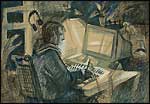Experts at a biotechnology company in New Zealand have discovered that some cows have a gene giving them a natural ability to produce skimmed milk.
The finding could be used to develop a dairy herd that produces low-fat milk, Chemistry & Industry magazine reports.
A cow with the "skimmed milk" gene was identified in 2001, and the team have since been able to breed calves that also produce the low-fat variety.
They say it could have a significant impact on the dairy industry.
The original cow - called Marge - produces milk that is very low in saturated fats, and so should be high in healthier polyunsaturates and monounsaturated fats.
Milk with this composition could also be used to make more spreadable butter.
Skimmed milk is currently made by removing much of the fatty cream contained in whole fat milk.
About 25% of milk sold in the UK today is full-fat. The rest is skimmed or semi-skimmed (skimmed milk with some fat added back).
Marge was discovered during a screening of milk compositions across New Zealand's four million cattle, carried out by biotech firm ViaLactia.
The low-fat gene then emerged in some of her calves, raising the possibility of developing commercial herds producing natural skimmed milk.
Potential impact
"When we found her daughters had the gene, that was the eureka moment, but the true holy grail will be to produce a sire with the gene," ViaLactia's chief scientist Russell Snell told New Zealand's Dominion Post newspaper.
High levels of saturated fats in people's diets - usually from a whole range of different sources - have been linked to an increased risk of heart disease and stroke. However, the dairy industry points out that whole milk as part of a balanced diet is not harmful.
Some experts express concern that continued demand for low fat dairy products could lead to a situation where excess fat separated from milk is wasted.
Ed Komorowski, technical director for Dairy UK, said that commercial dairy herds might suit some dairy firms but not others.
"By having cows producing skimmed milk, if you are a dairy company that only really wants skimmed milk, then you might want to get it straight from the cow, without having to separate the [cream out of the milk] and sell on the surplus," he told BBC News.
"The other side of that coin is that there are plenty of companies that will separate the cream to use in other products."
Mr Komorowski speculated that if, in future, whole milk could be made to contain unsaturated fats, it might draw some consumers back to buying this variety.
A typical pint of whole milk contains 3.5% saturated fat, a pint of semi-skimmed contains 1.7% and skimmed milk has 0.1% saturated fat content.








